Opinion & Analysis
Statistically-based pairings for the U.S. Ryder Cup team
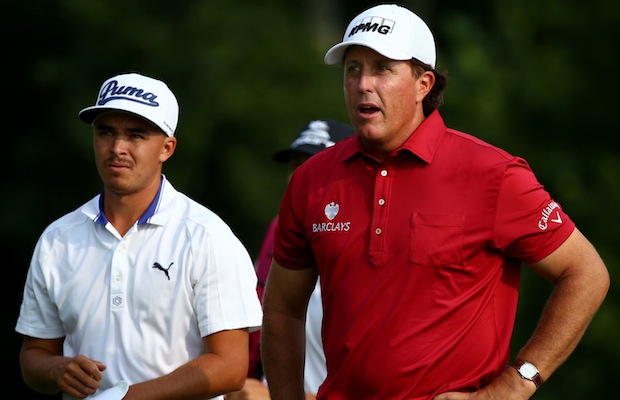
The U.S. Ryder Cup team appears to be — based on popular opinion — the heavy underdog against the Europeans. The U.S. team lost some key members due to Dustin Johnson’s leave of absence and Jason Dufner’s injuries that kept him from qualifying. Also, while Tiger Woods has not been a historically great Ryder Cup player, he is one of the best players in the world and a golfer the U.S. counts on for stability and leadership. His well-documented injuries and poor play, however, leave him sidelined for this year’s Ryder Cup.
On the opposing squad, the Europeans have had quite a strong year despite regressions in the play of two superstar players — Luke Donald (who did not make the team) and Lee Westwood.
Despite the opinion that the Europeans will win, I believe that if the U.S. team pairs players that are more statistically favorable instead of the “these two players are good friends, so we will pair them together” strategy, they have a realistic chance at winning the Ryder Cup. While I do not recall Davis Love III using a statistically-based pairing system, his pairings in 2012 mostly fit in line with what the numbers showed, and the U.S. team had a 10-6 lead going into Sunday. So his pairings were not the reason why the U.S. did not win at Medinah. Rather, the players simply failed to close out the Europeans on Sunday’s single matches.
For reference, here is a table of rankings for each member of the U.S. team in the key metrics for Ryder Cup play. The rankings are based out of 177 players:
General principles for pairing players in each format
Four-Ball Format: This is the ‘best score’ format. Therefore, this is more about scoring ability than ball-striking, short game and putting ability. The par-4 play is most important because there are more par-4’s than there are par-5’s and par-3’s. If the golfer is a poor performer on the par-5’s or par-3’s, then they should be paired with a player that performs well on those particular holes. Also, a high birdie-rate is preferable since the majority of time the team will be able to make at least a par.
Foursomes Format: This is the alternate shot format. Therefore, this is more about meshing together the players’ ball-striking, short game and putting ability. Short Game shots from 10-20 yards and the ability to save par is at a premium here. The foursomes format also tends to favor players that hit a lot of fairways, but that is not always needed if the rest of the players’ games jive well together. For example, a player that may miss a lot of fairways may work perfectly with another player that hits it well on shots from out of the rough.
Below is a brief analysis of each member on the U.S. team.
Keegan Bradley
Strengths: Par-4 play, Par-3 Play, All-Around Game
Weaknesses: Par-5 play, Iron play from 75-175 yards
Suitable Four-ball Partners: Fowler, Kuchar, Simpson, Spieth, Watson and Walker
Suitable Foursome Partners: Mickelson, Spieth and Watson
While Bradley did not win this season, he has the makeup of an excellent Ryder Cup player. What is interesting is that he struggled a bit on the par-5’s this year despite usually being an excellent par-5 player. With that, I would try and put Keegan with high birdie-rate players that play the par-5’s well in the four-ball format. Keegan should be a quality Foursome partner because he drives it very well and has a good short game. If he is a little off with his driving, it’s because he is missing fairways and I would pair him with good players from the rough that don’t make many bogeys.
Rickie Fowler
Strengths: Par-4 play, Par-5 play, Bogey-rate, Birdie Rate, Driving and shots from 10-20 yds
Weaknesses: Hit Fwy %, Shots from the Rough
Suitable Four-ball Partners: Bradley, Kuchar, Mickelson, Simpson, Watson, Walker
Suitable Foursome Partners: Furyk and Mahan
Fowler struggled massively with the putter early on and has made a huge turnaround on the greens since Riviera, so he is riding a hot putter coming into the Ryder Cup and played superbly in the majors this year. The only weaknesses are his play from the rough, and he does not hit a ton of fairways.
He is better in the four-ball format given his scoring metrics so you can pair him with just about anybody there. In the Foursome format, I would lean towards a good player from the rough that finds a lot of fairways so he does not have to hit many shots from the long grass.
Jim Furyk
Strengths: Par-4, Par-5 and Par-3 play. Bogey rate, Hit Fwy %, Iron Play, Short game
Weaknesses: Age and historically a poor Four-ball format player.
Suitable Four-ball Partners: N/A
Suitable Foursome Partners: Kuchar, Zach Johnson, and Simpson.
While Furyk plays the par-4’s, par-5’s and par-3’s superbly, he has historically struggled in the four-ball format because he is not a birdie-maker. Therefore, I would not even consider him in the four-ball format. He is better suited in the foursomes format because he finds fairways, hits greens and makes saves. I think he would be best with a player that also finds a lot of fairways, hits approach shots well from the fairway and is a good putter.
Zach Johnson
Strengths: Par-5 play, 175-225 yard play, Driving, fairway play, Hit Fwy %, Shots from 10-20 yards
Weaknesses: Age, Driving Distance, Shots from Rough
Suitable Four-ball Partners: Kuchar, Mickelson, Simpson, Spieth, Watson and Walker
Suitable Foursome Partners: Furyk, Kuchar, Mahan and Simpson
Johnson is much like Furyk except he is a more suitable player in the four-ball format because he makes more birdies. He is a player that Watson could possibly ride since he fits both formats pretty well. However, his putting has not been as good as people think (79th in Strokes Gained: Putting). So, in the foursomes format I would want to stick him with some good putters that keep the ball in the fairways.
Matt Kuchar
Strengths: Par-4 play, Bogey and Birdie Rates, Driving, Hit Fwy %, Shots from 175-225 yards, Short Game and Putting
Weaknesses: Driving Distance and shots from the rough
Suitable Four-ball Partners: Bradley, Fowler, Zach Johnson, Mahan, Reed, Simpson, Spieth, Watson and Walker
Suitable Foursome Partners: Furyk, Zach Johnson, Mahan and Simpson
Kuchar is more like Zach Johnson in that he fits in nicely in both formats and Tom Watson may want to ride him a bit. He suits almost anybody in the four-ball format. Given his troubles form the rough (130th), I would try and give him partners that find the fairway, strike it well from the fairway and can putt.
Hunter Mahan
Strengths: Par-4 play and Driving
Weaknesses: Par-3 play, Bogey Rate, Birdie Rate, Shots from 175-225 yds, Shots from the Fairway and Shots from 10-20 yards
Suitable Four-ball Partners: Kuchar, Watson and Walker
Suitable Foursome Partners: Fowler, Zach Johnson, Simpson and Spieth
The metrics show why I am not a fan of the Mahan pick. However, he has a decent track record in the Ryder Cup and played fairly well at the Open Championship. Mahan’s game has been highlighted by excellent driving and hamstrung by his inability to hit his irons well. This year he did not play well from 10-20 yards so this makes me a little more averse to putting him in the foursomes format.
I would like to see him with Bubba Watson in the four-ball format and re-create a similar team that Paul Azinger created with Boo Weekley and JB Holmes. Weekley, one of the best drivers in the world that hits the ball long and straight, would tee off first and consistently hit good drives past his opponents. If Weekley was in good position, that allowed Holmes a free rip to hit a drive 380 yards. I could see the same working with Mahan and Bubba.
Phil Mickelson
Strengths: Par-4 play, Bogey and Birdie Rate, Shots from the Rough and shots from 10-20 yards
Weaknesses: Hit Fwy % and Shots from the Fairway
Suitable Four-ball Partners: Fowler, Spieth, Simpson, Watson and Walker
Suitable Foursome Partners: Bradley, Spieth, Watson and Walker
While Mickelson had one of his worst seasons in recent memory, his game is better suited for the Ryder Cup this year than in year’s past. He is still a player best suited for the four-ball format because he plays all of the holes well and makes a lot of birdies. I know there will be the temptation to place him and Bradley together in the four-ball format. It is not a bad idea, but the numbers indicate that other players like Fowler and Watson would be better suited in the four-ball format.
In the foursomes format, Mickelson’s driving has improved enough that he is not a burden to his partner off the tee. However, that partner will still need to be able to hit it well from the rough as Phil does not find many fairways. I would pair him with good overall drivers of the ball that hit the irons well, particularly from the rough.
Patrick Reed
Strengths: Streaky fantastic play, great past record in match play.
Weaknesses: Streaky poor play, Driving, Hit Fwy %, Shots from the rough and shots from 10-20 yds
Suitable Four-ball Partners: Kuchar, Spieth and Walker
Suitable Foursome Partners: n/a
Reed is an extremely streaky player. His metrics are not very impressive, but what I have recorded is that when he is on, he is as good as he thinks he is. And when he is off, he shuts down and calls it a week.
I would steer clear of putting him in the foursomes format because he is not very accurate off the tee and he is not very good with the Short Game. I think the streaky player likely works best in the four-ball format where they can kind of do their own thing.
Webb Simpson
Strengths: Par-4 play, Birdie Rate, Shots from the Fairway, Shots from 10-20 yards, putting
Weaknesses: Shots from 175-225 yards, Shots from the rough
Suitable Four-ball Partners: Bradley, Fowler, Johnson, Kuchar, Mahan, Mickelson, Spieth, Watson and Walker
Suitable Foursome Partners: Furyk, Kuchar and Johnson.
Simpson was a bit of a controversial pick and I can understand why. He is best suited for the four-ball format, but has struggled to avoid Bogeys. He has some good metrics for the foursomes format, but has massively struggled on shots from 175-225 yards and shots from the rough. I think the obvious choice in the four-ball format is to stick him with Bubba Watson, which worked well in 2010. I would recommend using Simpson in the foursomes format in a pinch, but find a player that hits a lot of fairways and can get up-and-down for when Simpson misses the green.
Jordan Spieth
Strengths: Par-3, Par-4 and Par-5 play. Birdie Rate and Putting
Weaknesses: Hit Fairway %
Suitable Four-ball Partners: Bradley, Kuchar, Johnson, Mickelson, Reed, Simpson, Watson and Walker
Suitable Foursome Partners: Bradley, Mahan, Mickelson, Watson and Walker
Jordan should be a player that is suitable in both formats. He is better off in the four-ball format, but in the foursomes format they should try and protect against his occasional driving woes and find a player that strikes it well off the tee and can hit it well from the rough if Jordan misses the fairway.
Bubba Watson
Strengths: Par-4’s, Par-5’s, Birdie and Bogey Rates, Driving, Distance, Shots from the fwy, Shots from the rough,
Weaknesses: Hit Fairway %, Shots from 10-20 yards, Putting
Suitable Four-ball Partners: Bradley, Furyk, Johnson, Kuchar, Mickelson, Spieth and Walker
Suitable Foursome Partners: Bradley, Mickelson, Spieth and Walker
Watson is better suited in the four-ball format where he pretty much fits well with just about every player on the team. The only question mark is that historically Watson has been a poor player on the par-3’s. He has done a good job on the par-3’s this year (57th), but I would still be guarded against that and seek out the players that are strong on those holes.
In the foursomes format, the main emphasis should be on putting and short game play along with shots from the rough. He is actually more accurate off the tee than most people give credit for, but when he misses he tends to miss big and you need a player that can recover from those shots.
Jimmy Walker
Strengths: Par-3, Par-4, Par-5 play, Birdie and Bogey Rates, Shots from 175-225 yards, Shots from the Rough and Putting
Weaknesses: Driving and Hit Fairway %
Suitable Four-ball Partners: All players
Suitable Foursome Partners: Mickelson, Spieth and Watson
Walker looks to be a great fit in the four-ball format. He is like a poor man’s Mickelson — an ineffective driver of the ball due to his inaccuracy off the tee, but he hits it a long way and is a great iron player with a good short game and putts very well. In the foursomes format I would pair him with players that are good from the rough, but he is much better suited for the four-ball format.
The U.S. teams have traditionally been very well-suited in the four-ball format. This team is no different as most of the members of the team appear to be quite strong in that format. However, the foursomes format has given them issues and this is a team that is very suspect in this format. Therefore, I feel that Captain Tom Watson should likely focus most of his efforts on the alternate shot format and if the U.S. team can break even in that format, they stand a good chance of winning.
My recommendations for the Friday pairings for Team USA
Foursomes Format
Bradley/Mickelson
Furyk/Spieth
Walker/Watson
Johnson/Kuchar
Four-Ball Format
Mahan/Bubba
Reed/Walker
Fowler/Bradley
Spieth/Kuchar
- LIKE0
- LEGIT0
- WOW0
- LOL0
- IDHT0
- FLOP0
- OB0
- SHANK0
Opinion & Analysis
The Wedge Guy: What really makes a wedge work? Part 1

Of all the clubs in our bags, wedges are almost always the simplest in construction and, therefore, the easiest to analyze what might make one work differently from another if you know what to look for.
Wedges are a lot less mysterious than drivers, of course, as the major brands are working with a lot of “pixie dust” inside these modern marvels. That’s carrying over more to irons now, with so many new models featuring internal multi-material technologies, and almost all of them having a “badge” or insert in the back to allow more complex graphics while hiding the actual distribution of mass.
But when it comes to wedges, most on the market today are still single pieces of molded steel, either cast or forged into that shape. So, if you look closely at where the mass is distributed, it’s pretty clear how that wedge is going to perform.
To start, because of their wider soles, the majority of the mass of almost any wedge is along the bottom third of the clubhead. So, the best wedge shots are always those hit between the 2nd and 5th grooves so that more mass is directly behind that impact. Elite tour professionals practice incessantly to learn to do that consistently, wearing out a spot about the size of a penny right there. If impact moves higher than that, the face is dramatically thinner, so smash factor is compromised significantly, which reduces the overall distance the ball will fly.
Every one of us, tour players included, knows that maddening shot that we feel a bit high on the face and it doesn’t go anywhere, it’s not your fault.
If your wedges show a wear pattern the size of a silver dollar, and centered above the 3rd or 4th groove, you are not getting anywhere near the same performance from shot to shot. Robot testing proves impact even two to three grooves higher in the face can cause distance loss of up to 35 to 55 feet with modern ‘tour design’ wedges.
In addition, as impact moves above the center of mass, the golf club principle of gear effect causes the ball to fly higher with less spin. Think of modern drivers for a minute. The “holy grail” of driving is high launch and low spin, and the driver engineers are pulling out all stops to get the mass as low in the clubhead as possible to optimize this combination.
Where is all the mass in your wedges? Low. So, disregarding the higher lofts, wedges “want” to launch the ball high with low spin – exactly the opposite of what good wedge play requires penetrating ball flight with high spin.
While almost all major brand wedges have begun putting a tiny bit more thickness in the top portion of the clubhead, conventional and modern ‘tour design’ wedges perform pretty much like they always have. Elite players learn to hit those crisp, spinny penetrating wedge shots by spending lots of practice time learning to consistently make contact low in the face.
So, what about grooves and face texture?
Grooves on any club can only do so much, and no one has any material advantage here. The USGA tightly defines what we manufacturers can do with grooves and face texture, and modern manufacturing techniques allow all of us to push those limits ever closer. And we all do. End of story.
Then there’s the topic of bounce and grinds, the most complex and confusing part of the wedge formula. Many top brands offer a complex array of sole configurations, all of them admittedly specialized to a particular kind of lie or turf conditions, and/or a particular divot pattern.
But if you don’t play the same turf all the time, and make the same size divot on every swing, how would you ever figure this out?
The only way is to take any wedge you are considering and play it a few rounds, hitting all the shots you face and observing the results. There’s simply no other way.
So, hopefully this will inspire a lively conversation in our comments section, and I’ll chime in to answer any questions you might have.
And next week, I’ll dive into the rest of the wedge formula. Yes, shafts, grips and specifications are essential, too.
- LIKE19
- LEGIT6
- WOW1
- LOL1
- IDHT2
- FLOP2
- OB1
- SHANK1
Golf's Perfect Imperfections
Golf’s Perfect Imperfections: Amazing Session with Performance Coach Savannah Meyer-Clement

In this week’s episode, we spent some time with performance coach Savannah Meyer-Clement who provides many useful insights that you’ll be able to implement on the golf course.
- LIKE0
- LEGIT0
- WOW0
- LOL0
- IDHT0
- FLOP0
- OB0
- SHANK0
19th Hole
Vincenzi’s 2024 RBC Heritage betting preview: Patrick Cantlay ready to get back inside winner’s circle

Just a two-hour drive from Augusta National, the PGA TOUR heads to Harbour Town Golf Links in Hilton Head Island, S.C. Hilton Head Island is a golfer’s paradise and Harbour Town is one of the most beautiful and scenic courses on the PGA TOUR.
Harbour Town Golf Links is a par-71 that measures 7,121 yards and features Bermuda grass greens. A Pete Dye design, the course is heavily tree lined and features small greens and many dog legs, protecting it from “bomb-and-gauge” type golfers.
The field is loaded this week with 69 golfers with no cut. Last year was quite possibly the best field in RBC Heritage history and the event this week is yet another designated event, meaning there is a $20 million prize pool.
Most of the big names on the PGA Tour will be in attendance this week with the exceptions of Hideki Matsuyama and Viktor Hovland. Additionally, Webb Simpson, Shane Lowry, Gary Woodland and Kevin Kisner have been granted sponsors exemptions.
Past Winners at Harbour Town
- 2023: Matt Fitzpatrick (-17)
- 2022: Jordan Spieth (-13)
- 2021: Stewart Cink (-19)
- 2020: Webb Simpson (-22)
- 2019: CT Pan (-12)
- 2018: Sotoshi Kodaira (-12)
- 2017: Wesley Bryan (-13)
- 2016: Branden Grace (-9)
- 2015: Jim Furyk (-18)
In this article and going forward, I’ll be using the Rabbit Hole by Betsperts Golf data engine to develop my custom model. If you want to build your own model or check out all of the detailed stats, you can sign up using promo code: MATTVIN for 25% off any subscription package (yearly is best value).
Key Stats For Harbour Town
Let’s take a look at key metrics for Harbour Town Golf Links to determine which golfers boast top marks in each category over their past 24 rounds.
Strokes Gained: Approach
Strokes Gained: Approach is exceedingly important this week. The greens at Harbour Town are about half the size of PGA TOUR average and feature the second-smallest greens on the tour. Typical of a Pete Dye design, golfers will pay the price for missed greens.
Total SG: Approach Over Past 24 Rounds
- Scottie Scheffler (+1.27)
- Tom Hoge (+1.27)
- Corey Conners (+1.16)
- Austin Eckroat (+0.95)
- Cameron Young (+0.93)
Good Drive %
The fairways at Harbour Town are tree lined and feature many dog legs. Bombers tend to struggle at the course because it forces layups and doesn’t allow long drivers to overpower it. Accuracy is far more important than power.
Good Drive % Over Past 24 Rounds
- Brice Garnett (88.8%)
- Shane Lowry (+87.2%)
- Akshay Bhatia (+86.0%)
- Si Woo Kim (+85.8%)
- Sepp Straka (+85.1%)
Strokes Gained: Total at Pete Dye Designs
Pete Dye specialists tend to play very well at Harbour Town. Si Woo Kim, Matt Kuchar, Jim Furyk and Webb Simpson are all Pete Dye specialists who have had great success here. It is likely we see some more specialists near the top of the leaderboard this week.
SG: TOT Pete Dye per round over past 36 rounds:
- Xander Schauffele (+2.27)
- Scottie Scheffler (+2.24)
- Ludvig Aberg (+2.11)
- Brian Harman (+1.89)
- Sungjae Im (+1.58)
4. Strokes Gained: Short Game (Bermuda)
Strokes Gained: Short Game factors in both around the green and putting. With many green-side bunkers and tricky green complexes, both statistics will be important. Past winners — such as Jim Furyk, Wes Bryan and Webb Simpson — highlight how crucial the short game skill set is around Harbour Town.
SG: SG Over Past 24 Rounds
- Jordan Spieth (+1.11)
- Taylor Moore (+1.02)
- Wyndham Clark (+0.98)
- Mackenzie Hughes (+0.86)
- Andrew Putnam (+0.83)
5. Greens in Regulation %
The recipe for success at Harbour Town Golf Links is hitting fairways and greens. Missing either will prove to be consequential — golfers must be in total control of the ball to win.
Greens in Regulation % over past 24 rounds:
- Brice Garnett (+75.0%)
- Scottie Scheffler (+69.9%)
- Corey Conners (+69.0%)
- Shane Lowry (+68.3%)
- Patrick Rodgers (+67.6%)
6. Course History
Harbour Town is a course where players who have strong past results at the course always tend to pop up.
Course History over past 24 rounds:
- Patrick Cantlay (+2.34)
- Cam Davis (+2.05)
- J.T. Poston (+1.69)
- Justin Rose (+1.68)
- Tommy Fleetwood (+1.59)
The RBC Heritage Model Rankings
Below, I’ve compiled overall model rankings using a combination of the five key statistical categories previously discussed — SG: Approach (24%), Good Drives (20%), SG: SG (14%), SG: Pete Dye (14%), GIR (14%), and Course History (14%)
- Shane Lowry
- Russell Henley
- Scottie Scheffler
- Xander Schauffele
- Corey Conners
- Wyndham Clark
- Christiaan Bezuidenhout
- Matt Fitzpatrick
- Cameron Young
- Ludvig Aberg
2024 RBC Heritage Picks
Patrick Cantlay +2000 (FanDuel)
With the exception of Scottie Scheffler, the PGA Tour has yet to have any of their star players show peak form during the 2024 season. Last week, Patrick Cantlay, who I believe is a top-5 players on the PGA Tour, took one step closer to regaining the form that’s helped him win eight events on Tour since 2017.
Cantlay limped into the Masters in poor form, but figured it out at Augusta National, finishing in a tie for 20th and ranking 17th for the week in Strokes Gained: Ball Striking. The former FedEx Cup champion will now head to one of his favorite golf courses in Harbour Town, where he’s had immaculate results over the years. In his six trips to the course, he’s only finished worse than 7th one time. The other finishes include three third places (2017, 2019, 2023) and one runner-up finish (2022). In his past 36 rounds at Harbour Town, Cantlay ranks 1st in Strokes Gained: Total per round at the course by a wide margin (+2.36).
Cantlay is winless since the 2022 BMW Championship, which is far too long for a player of his caliber. With signs pointing to the 32-year-old returning to form, a “signature event” at Harbour Town is just what he needs to get back on the winning track.
Tommy Fleetwood +3000 (FanDuel)
I truly believe Tommy Fleetwood will figure out a way to win on American soil in 2024. It’s certainly been a bugaboo for him throughout his career, but he is simply too talented to go another season without winning a PGA Tour event.
At last week’s Masters Tournament, Fleetwood made a Sunday charge and ended up finishing T3 in the event, which was his best ever finish at The Masters. For the week, the Englishman ranked 8th in the field in Strokes Gained: Approach, 10th in Strokes Gained: Ball Striking and 16th in Strokes Gained: Putting.
Harbour Town is a perfect layout for Fleetwood, and he’s had relative success at this Pete Dye design in the past. In his four trips to the course, he’s finished inside of the top 25 three times, with his best finish, T10, coming in 2022. The course is pretty short and can’t be overpowered, which gives an advantage to more accurate players such as Fleetwood. Tommy ranks 8th in the field in Good Drive % and should be able to plot his way along this golf course.
The win is coming for Tommy lad. I believe there’s a chance this treasure of a golf course may be the perfect one for him to finally break through on Tour.
Cameron Young +3300 (FanDuel)
Cameron Young had a solid Masters Tournament last week, which is exactly what I’m looking for in players who I anticipate playing well this week at the RBC Heritage. He finished in a tie for 9th, but never felt the pressure of contending in the event. For the week, Young ranked 6th in Strokes Gained: Off the Tee and 6th in Strokes Gained: Ball Striking.
Despite being one of the longest players off the tee on the PGA Tour, Young has actually played some really good golf on shorter tracks. He finished T3 at Harbour Town in 2023 and ranks 20th in the field in Good Drive% and 16th in Greens in Regulation in his past 24 rounds. He also has strong finishes at other shorter courses that can take driver out of a players hand such as Copperhead and PGA National.
Young is simply one of the best players on the PGA Tour in 2024, and I strongly believe has what it takes to win a PGA Tour event in the very near future.
Corey Conners +5500 (FanDuel)
Corey Conners has had a disappointing year thus far on the PGA Tour, but absolutely loves Harbour Town.
At last week’s Masters Tournament, the Canadian finished T30 but ranked 20th in the field in Strokes Gained: Approach. In his past 24 rounds, Conners ranks 3rd in the field in Strokes Gained: Approach, 3rd in Greens in Regulation % and 24th in Good Drive %.
In Conners’ last four trips to Harbour Town, his worst finish was T31, last season. He finished T4 in 2021, T12 in 2022 and ranks 8th in Strokes Gained: Total at the course over his past 36 rounds.
Conners hasn’t been contending, but his recent finishes have been encouraging as he has finished in the top-25 in each of his past three starts prior to The Masters, including an impressive T13 at The PLAYERS. His recent improvement in ball striking as well as his suitability for Harbour Town makes Conners a high upside bet this week.
Shane Lowry (+7500) (FanDuel)
When these odds were posted after Lowry was announced in the field, I have to admit I was pretty stunned. Despite not offering much win equity on the PGA Tour over the last handful of years, Shane Lowry is still a top caliber player who has the ability to rise to the top of a signature event.
Lowry struggled to score at The Masters last week, but he actually hit the ball really well. The Irishman ranked 1st for Strokes Gained: Approach on the week and 7th in Strokes Gained: Ball Striking. As usual, it was the putter that let him down, as he ranked 60th in the field in Strokes Gained: Putting.
Harbour Town is most definitely one of Lowry’s favorite courses on the PGA Tour. In his six starts there, he’s finished in the top 10 three times, including third twice. Lowry is sensational at Pete Dye designs and ranks 7th in Strokes Gained: Total in his past 36 rounds on Dye tracks.
Lowry is perfect for Harbour Town. In his past 24 rounds, he ranks 5th in Strokes Gained: Approach, 2nd in Good Drive% and 5th in Green in Regulation %. If he figures it out on the greens, Shane could have his first win in America since 2015.
Lucas Glover +12000 (FanDuel)
This is one of my weekly “bet the number” plays as I strongly believe the odds are just too long for a player of Glover’s caliber. The odds have been too long on Glover for a few weeks now, but this is the first event that I can get behind the veteran being able to actually contend at.
Glover is quietly playing good golf and returning to the form he had after the understandable regression after his two massive victories at the end of 2023. He finished T20 at The Masters, which was his best ever finish at Augusta National. For the week, Lucas ranked 18th for Strokes Gained: Approach and 20th in Strokes Gained: Ball Striking.
Over his past 24 rounds, Glover ranks 9th in Strokes Gained: Approach and 13th in Good Drive %. Harbour Town is a short course that the 44-year-old will be able to keep up with the top players on Tour off the tee. He’s played the course more than 20 times, with mixed results. His best finishes at Harbour Town include a T7 in 2008, but recently has a finish of T21 in 2020.
Glover has proven he can contend with the stars of the Tour on any given week, and this number is flat out disrespectful.
- LIKE30
- LEGIT5
- WOW2
- LOL1
- IDHT1
- FLOP2
- OB0
- SHANK2
-

 19th Hole1 week ago
19th Hole1 week agoDave Portnoy places monstrous outright bet for the 2024 Masters
-

 19th Hole3 weeks ago
19th Hole3 weeks agoThings got heated at the Houston Open between Tony Finau and Alejandro Tosti. Here’s why
-

 19th Hole1 week ago
19th Hole1 week agoTiger Woods arrives at 2024 Masters equipped with a putter that may surprise you
-

 19th Hole2 weeks ago
19th Hole2 weeks agoReport: Tiger Woods has ‘eliminated sex’ in preparation for the 2024 Masters
-

 19th Hole5 days ago
19th Hole5 days agoTwo star names reportedly blanked Jon Rahm all week at the Masters
-

 19th Hole4 days ago
19th Hole4 days agoNeal Shipley presser ends in awkward fashion after reporter claims Tiger handed him note on 8th fairway
-

 19th Hole3 days ago
19th Hole3 days agoReport: LIV Golf identifies latest star name they hope to sign to breakaway tour
-

 19th Hole2 weeks ago
19th Hole2 weeks agoAddiction, spinal fusion, and scam artists – Everything Anthony Kim revealed in candid interview with David Feherty

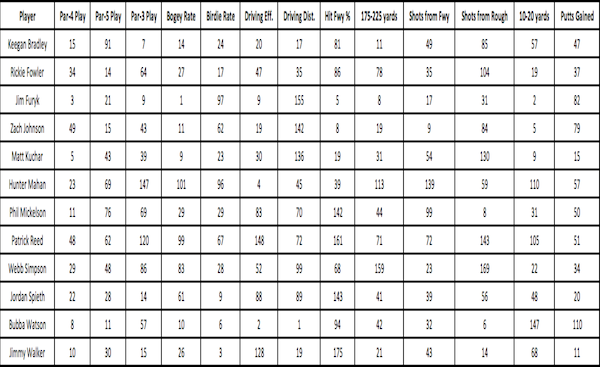
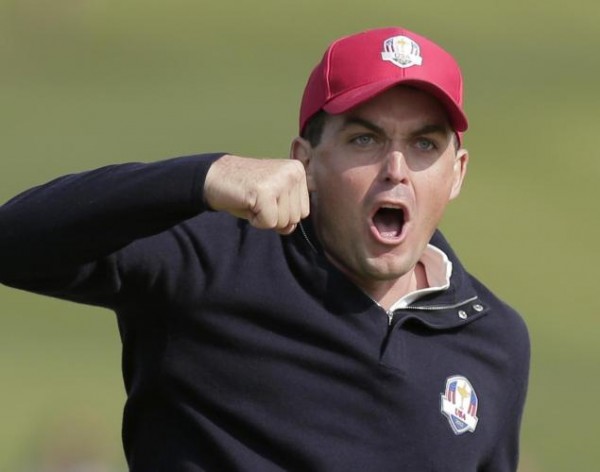
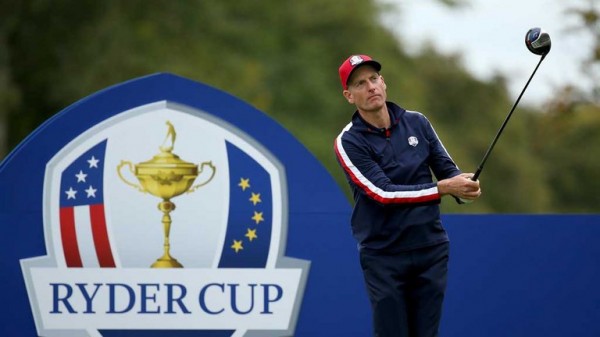
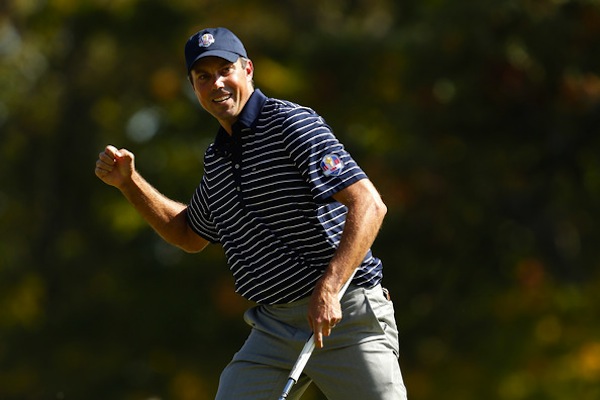

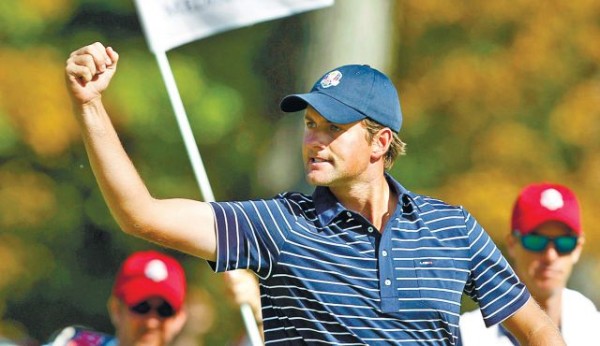
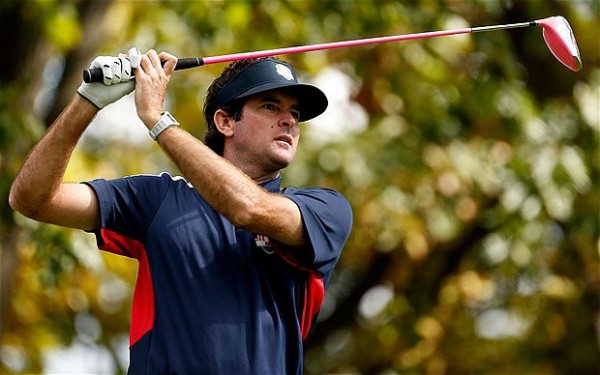


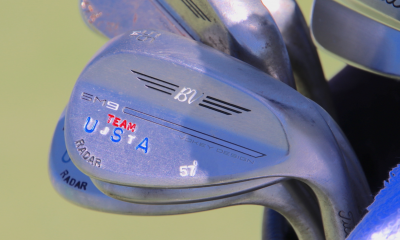

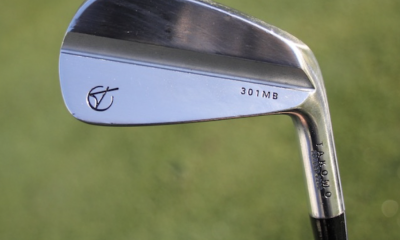

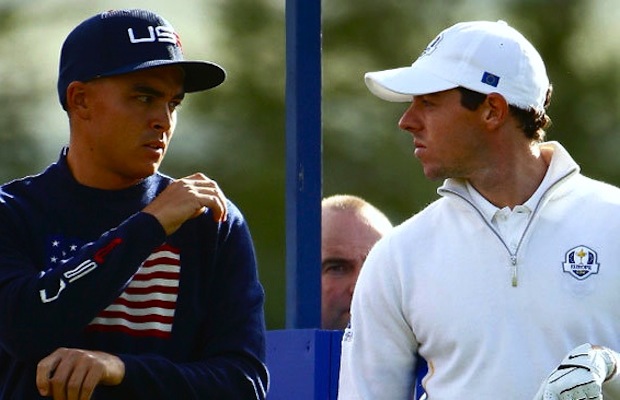
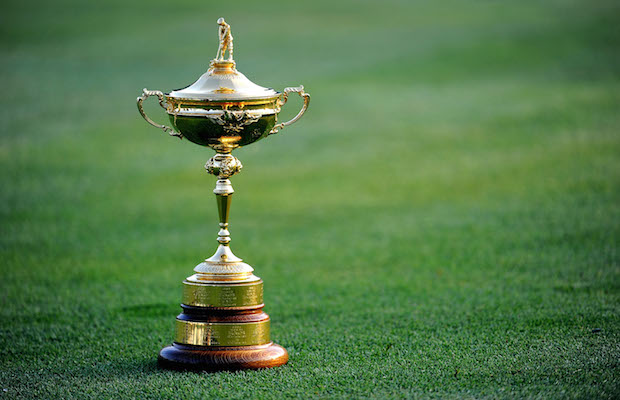
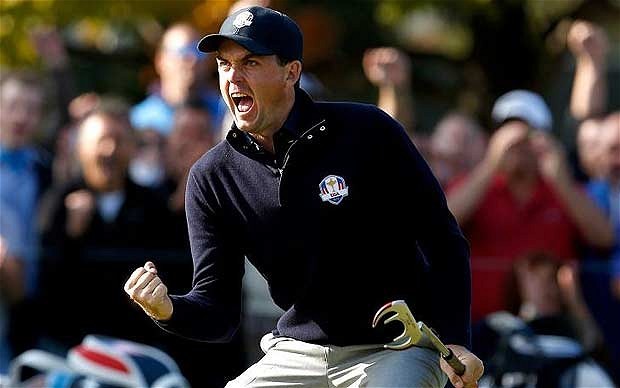
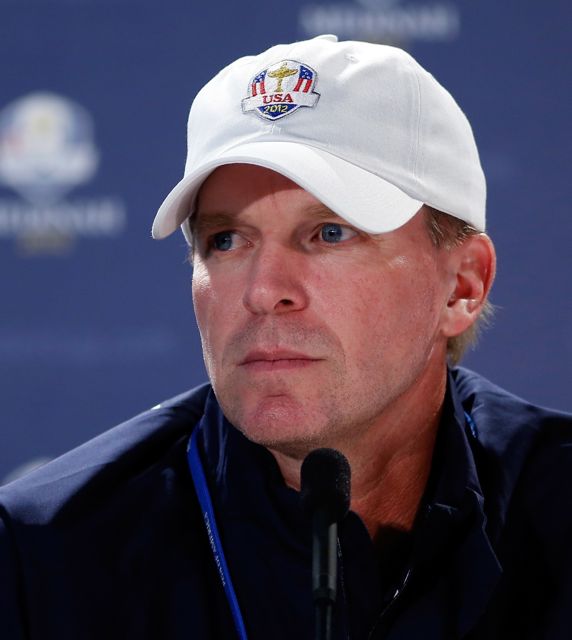













Pingback: ¿Cómo se confeccionan las parejas de la Ryder Cup? - Golf76.com
Greg Palmer
Sep 24, 2014 at 8:27 am
I think metrics have become an important component to every sport, golf included, but by design, what they don’t take into account are the emotional nuances which are also critical elements – especially at events like this. The “statistical” approach alone has never produced a championship of any kind that I can remember. Clearly, champions produce mostly great statistics –
If I were managing the pairings, I would be looking for a combination of statistics, guts for the moment, past records and experience to a point, and the ability to deliver on the big day. Obviously, being hot right now is a good thing too!
Currently, the hottest players on the fall playoff list – a list in which Americans have 8 of the top 10 players – feature 6 American Ryder Cuppers. The top 2, Horschel and Kirk are out. That leaves in order 4-9: Furyk, Watson, Mahan, Walker, Kuchar, and Fowler. Spieth was not far behind, Simpson and Zach Johnson also were right there.
Patrick Reed is the wildcard. He’s cocky and very streaky which might play out well in this format.
Mickelson and Bradley are known commodities, 3-0-1 in 4somes and 2-1 in 4ball, and should be used together as long as they are competitive in these matches. If healthy and feeling good, they are a must play in every team match (3 of 4 for sure).
Furyk scares me because his Ryder Cup record is awful! He is a gritty and tough grinder and I would be looking to pair him with another hot golfer out of the gate in foursomes – maybe even a rookie to bring some energy/spark to his play. He is 1-8-1 in fourball at the Ryder Cup, and therefore, he would not play one fourball match for me all weekend.
In terms of matchups, I want Mickelson or Fowler going up against Rory at every possible team match. I might even throw Bubba in there for length at times, but Mickelson and Fowler played on the big stage this summer with Rory and if not for a couple of errors, either could have won a major – and Fowler multiple. To me, Fowler is the horse for the Americans in these matches – a must-play in all 5 games.
For Friday, if I’m trying to win and combine what I know about metrics and guts, I’m going with:
Foursomes
Bradley/Mickelson
Fowler/Spieth or Mahan
Walker/Furyk
Watson/Kuchar
Four-Ball Format on Friday afternoon – I want Fowler, Mickelson and Watson anchoring a team each. All can make birdies like crazy and that is what I want in this format. I would be making my afternoon pairings based on morning performance. Rotating out the guys who are average and keep in the guys who are hot. Hardly a rocket science idea.
Possible Pairings:
Fowler/Reed
Watson/Mahan or Spieth depending on how the morning went
Mickelson/Bradley or Simpson
Walker/Johnson
One of the real wildcards in these matches will be Tom Watson. He has become even more stubborn with age and I am not confident in his ability to make adjustments on the fly. We’ll see how it plays out, but I sort of like the idea of being underdog – could play out well.
Greg Palmer
Sep 29, 2014 at 9:59 am
Just looking back, the US Team faced a huge uphill battle to win these matches, but the Captain did not do them any favors. Past Captains felt that Mickelson’s comments were out of line, but he is probably mostly right about what he said.
Watson did not make sound adjustments either day during the afternoon matches. The hottest team on the entire golf course dispatched their European opponents in 14 holes in the morning on Friday, and at ages 21 and 25, sat the afternoon. This was a very strong indicator that Watson was completely out of touch.
And then to sit Mickelson for the entire day on Saturday made no sense after he played twice and went 1-1 on Friday.
The coach never put these guys into position to win. Not that they could have anyway, but he did not nothing to help the cause.
Finally, Bubba Watson showed once again why he can’t be relied on in these matches.
Todd Barnes
Sep 24, 2014 at 2:19 am
Or a Zach Johnson/ Kuchar pairing instead of Fowler from a statistical view but Rickys swing changes seem to have taken hold and his numbers the last couple of months off the tee are much better than at the start of the season. Thanks Rich.
Richie Hunt
Sep 24, 2014 at 11:11 am
Fowler hasn’t had many issues off the tee this year to begin with. What was plaguing him was his putting was atrocious early on (worst on Tour in Strokes Gained – Putting). He then turned it around.
I don’t think he is a bad player for the 4-some format. But, he doesn’t hit a lot of fairways, he’s only decent from 175-225 yards and is below average on shots from the rough. So, you will need to pair him with a partner that hits a lot of fairways, hits it well from the rough and has a really good short game in case Fowler misses from 175-225 yards.
If you look at the history of the event, you’re better off trying to get as many golfers out playing on Friday as possible. My pairings have all but 1 player playing the first day (Webb Simpson). That way you’re not burning out players, the players are not coming off the bench cold and Tom Watson can get a better feel for who is playing well and who is not and then plan accordingly for Saturday.
Todd Barnes
Sep 24, 2014 at 12:55 pm
That makes sense Rich, I’m just terrified of which Phil will show up for a foursomes match day 1. Hopefully Bradley/Mickelson will pick up where they left off from Medinah. What if you did a Bradley/ Mahan foursome and a Mickelson/ Watson fourball for day 1 and left the rest of your pairings alone?
truth
Sep 23, 2014 at 11:21 pm
fowler needs to play in every match everyday for usa to have a chance. None of the people you have playing twice on friday should be unless you want usa to be in a big hole after the first day
Richie Hunt
Sep 24, 2014 at 11:07 am
Difficult to not have several golfers playing in both matches on Friday because of how the Ryder Cup is set up. And if you look at the history of the Ryder Cup, usually the team that stockpiles their players on Friday, falter on Saturday and Sunday. It burns out those players that played and the apparently the players that have to play end up ‘coming off the bench’ cold.
Not sure why Fowler has to play every match. It’s very arguable that he is even the best player on the team. And he has had a less than stellar Ryder Cup record.
Philip
Sep 23, 2014 at 8:17 pm
Very interesting, I like how you lined up the stats. Of course, the final deciding factor would be whether they gel with each other, but the stats are definitely a good start.
What was the thing about age as a weakness for only Zach and Jim?
ally smith
Sep 23, 2014 at 7:27 pm
Great read, Hope the boys do well and put a good show. Either way i know i’ll enjoy this week end. Great writing Rich, always appreciate your work.
Cheers !!!
TR1PTIK
Sep 23, 2014 at 6:46 pm
Interesting that you list “age” as a weakness for Jim Furyk and Zach Johnson, but not Phil Mickleson. Nor do you list age as a strength for any of the younger players – not sure what age has to do with anything anyway. I stopped reading as soon as I got to that point. Maybe you can find something else to write about like knitting or something.
Richie Hunt
Sep 23, 2014 at 7:43 pm
Mickelson and age was a simple oversight when I looked at weaknesses. But, I fully believe that is an issue since he dropped out of 4-some match on Saturday at Medinah and has had some injury issues this season.
As far as it being a ‘strength’ for younger players, I just don’t think that youth can actually be a strength. It’s a nice benefit if the player starts out on fire because you can use them for the rest of the event. But, if they are playing lousy…youth is not going to change that.
TR1PTIK
Sep 24, 2014 at 6:19 am
I get what you’re saying, but still don’t see what age has to do with anything. Mickleson has a well-known arthritic condition, and Matt Kuchar has had issues with his back this season. Furyk and Johnson? Nothing that I’ve heard of this season. I guess you could argue that they could fatigue faster or something, but then again, the world no. 1 Rory McIlroy used fatigue to brush off his poor play in the playoffs. Bottom line, age isn’t a good reason to discredit someone when you’re talking golf. All of this coming from a 27 year old by the way…
Mark Davis
Sep 23, 2014 at 5:55 pm
Thanks so much for this excellent breakdown going into the Cup. No doubt many will argue but it’s great to read an analysis from which we can start our own pondering… especially if, like me, you’re weak on stats and ares going with much more informal evaluations of the players.
It’s Ryder Cup. Anybody can rise, anybody can fall, anything can happen.
John
Sep 23, 2014 at 4:59 pm
C’mon… We wanna win this damn thing. Here we go:
Foursomes
Bradley/Mickelson
Speith/Fowler
Mahan/Furyk
Watson/Simpson
Fourball
Bradley/Mickelson
Watson/Mahan
Fowler/Johnson
Speith/Simpson
Now I’ll accept a rebuttal…
Richie Hunt
Sep 23, 2014 at 5:37 pm
One of the issues is that you only have 10 different players on day 1. We have to be leery of burning out our players and having them get ‘cold’ by having to wait until Saturday to play. Reed is a good example because he is not suited for the 4-some format. So if he doesn’t play on Friday, he’ll have to wait until Saturday afternoon to finally play. I only left out 1 player (Simpson), but he was a captain’s pick and has the experience to wait a little. And I can use him in the 4-some format if necessary.
Mickelson and Bradley in the 4-ball format I’m a bit averse to because Keegan hasn’t played the par-5’s well this year and Mickelson has been decent. I would rather go with what I feel are stronger pairings and also give Phil some rest for the 4-some format with Keegan for Saturday if possible.
I don’t think your pairings are bad by any means and if Watson were to go that route I think it’s not a bad job of pairing players, but I do think there are some better teams out there statistically that go beyond the ‘big names.’ I am also curious on how well Reed performs because I could see him getting out on Friday and dominating and then we can ride him on Saturday.
Todd Barnes
Sep 24, 2014 at 1:24 am
Hey Rich, love your moneyball approach as I believe that the USA won’t win until they start getting the RIGHT players, not the best players. 1980 USA hockey should be a lesson but the USA hasn’t seemed to learn it yet. Anyways, my question is why did you put Mickelsons/ Bradley in fours some? Mickelson and Bradley are both so streaky off the tee but can make tons of birdies in the four ball matches which you didn’t put them in so I am wondering why. Also I would put Kuchar/Fowler in foursomes because they both drive and putt really well, and move Mickelson/ Bradley to fourbball to light up Europe. Now I would like to know why my idea is bad. Thanks again love your articles.
Todd Barnes
Sep 24, 2014 at 2:25 am
Or a Zach Johnson/ Kuchar pairing for foursomes instead of Fowler/Kuchar but from a statistical view but Rickys swing changes seem to have taken hold and his numbers the last couple of months off the tee are much better than at the start of the season. Thanks Rich.